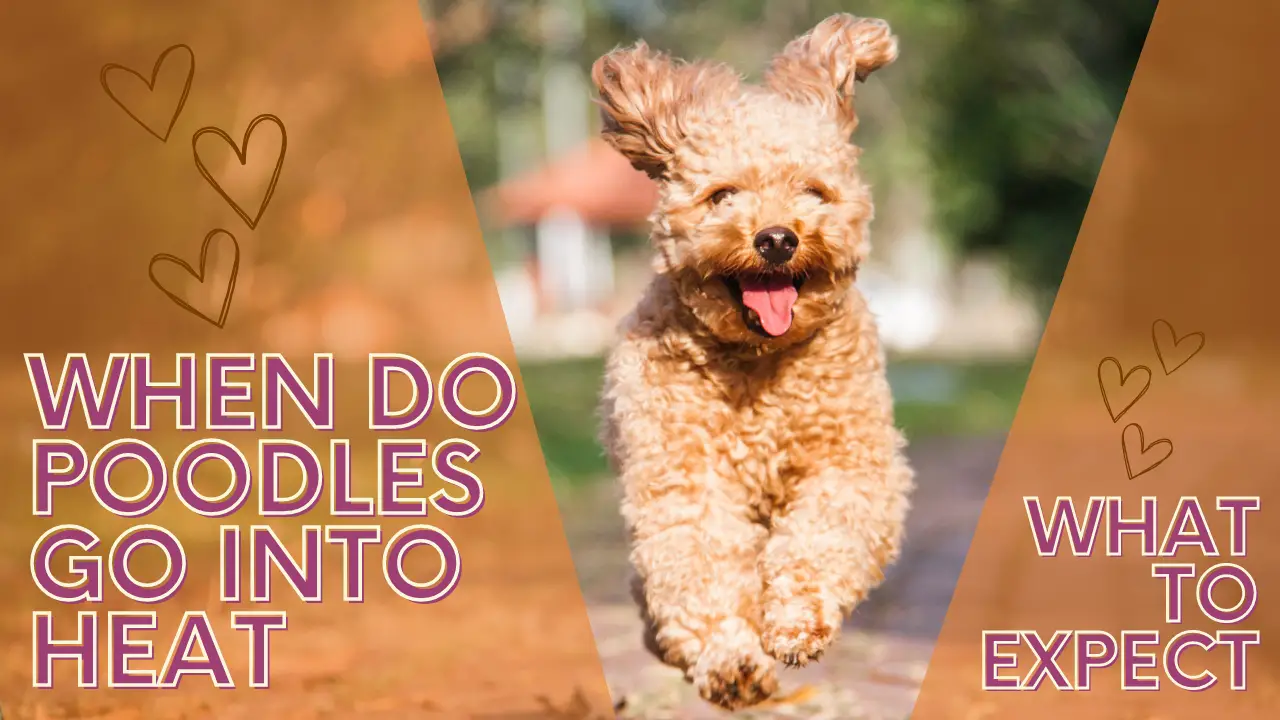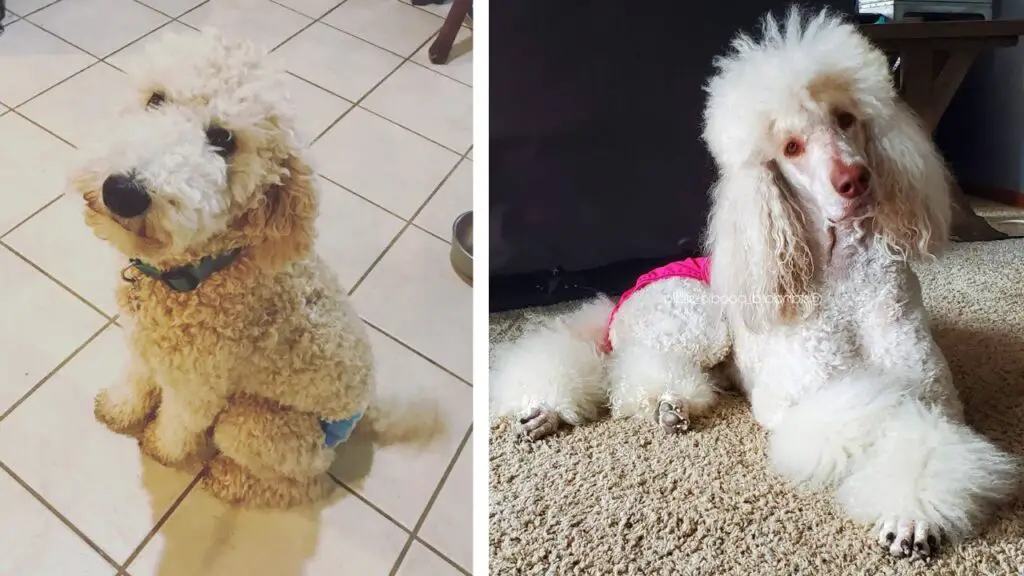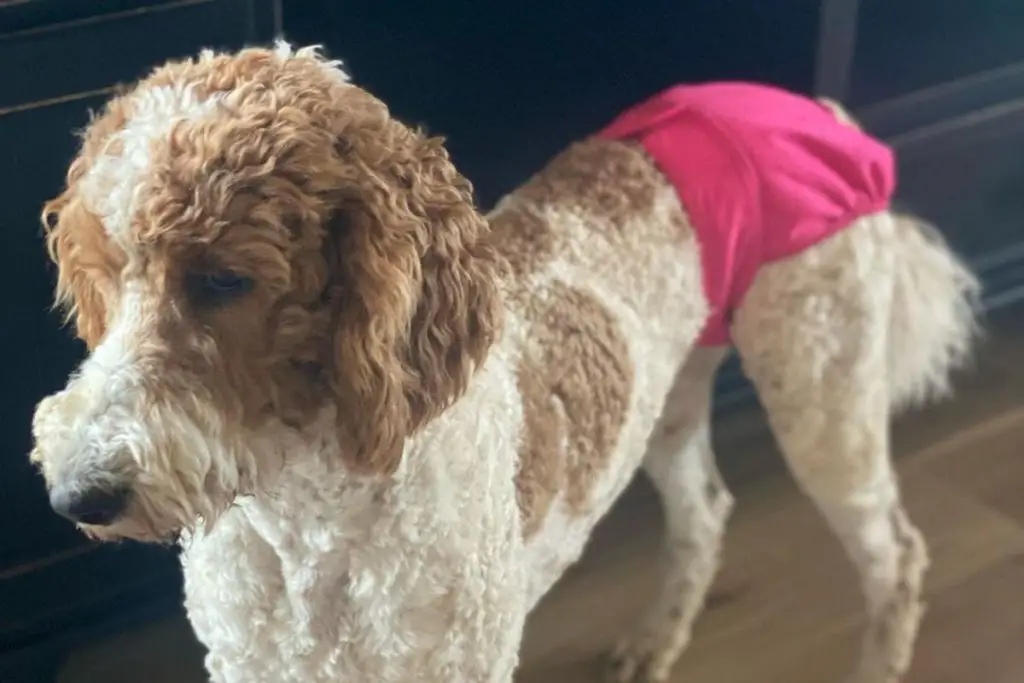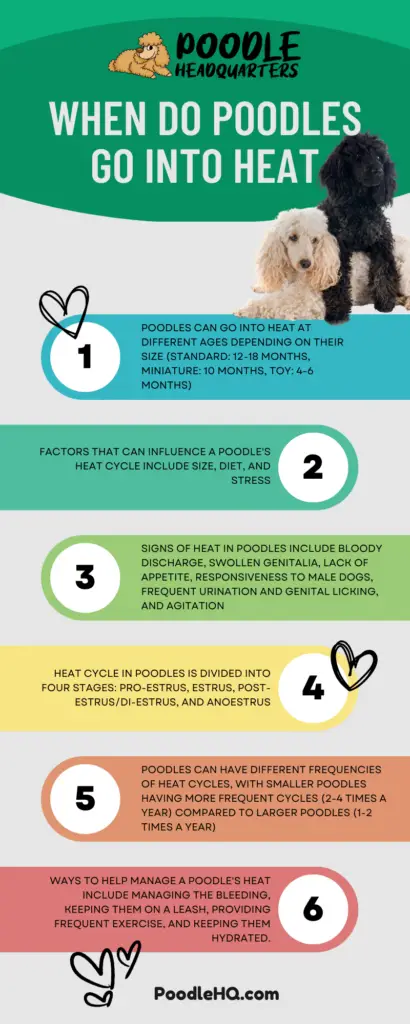Poodles are amazing dogs regardless of their gender. Sometimes though, females tend to get overlooked due to their periods.

In fact, the thought of them can often scare a lot of people into owning them due to the maintenance they come with. Plus, their heat might make for awkward conversations in the family household, which no one wants.
However, heat in Poodles isn’t that bad or a taboo topic if you know when it occurs and how to manage it. Arguably, this is a small factor to put up with if you want to reap the amazing benefits of a female Poodle’s personality.

Read our Smart Poodles - Smart Tricks eBook for only $2.99
Dive into a treasure trove of engaging tricks and tips designed specifically for your poodle!
It’s relatively easy to handle their heat, and to help you today, we’re going to cover everything on this topic ranging from the signs, symptoms, stages, and more.
What Will You Learn? 👇
When do poodles have their first heat?
If you plan to own a Poodle from a puppy, then be prepared for a female to go into heat between 10-12 months of age. But when it’s their first heat, the timings can vary; therefore, you can expect anything from 6-18 months. The reason why timings are different is all down to the variables that can influence their cycle.
Vet tip: Sometimes the first cycle is a ‘split heat’. The bitch goes out of heat before going back into it, and ovulating. Signs of the first oestrus are often not very noticeable.
Size
Due to the different sizes, a Poodle can come in, i.e., a Standard, Miniature, and Toy, their heat cycle can vary.
Most of the time, smaller Poodle breeds will experience more heat cycles throughout the year than bigger Poodles like the Standard.
When will my standard Poodle go into heat?
Standard Poodles can grow up to 15 inches / 38cm, and due to their large size, they will experience their first heat around the 12-18 month age bracket . With this type of Poodle, you can expect them only to have one or two heat cycles a year.
When will my miniature Poodle go into heat?
Miniature Poodles are smaller than 15 inches / 38cm, and their first heat usually occurs at the 10-month mark . On average, they will have 2-3 heats in a year.
When will my toy poodle go into heat?
Toy Poodles are the smallest Poodle breed that exists and usually grow up to around 10 inches / 25cm if not smaller. As they are the smallest, their heat starts as early as 4-6 months, and you can expect them to have 2-4 heat cycles a year.
Diet
The diet of a Poodle can play an essential role in when her heat occurs and how long it occurs. If you feed a Poodle a bad diet that lacks essential nutrients, it could take them longer to go through heat. On the contrary, if you feed them a well-balanced healthy diet, their heat will be more regular, and their first heat might happen earlier.
Stress
Stressful environments can cause a Poodle’s heat cycle to be delayed. In particular, restricting a Poodle’s movement, like putting them in a cage or not taking them for long walks, can cause stress. Moreover, if they’re left alone for long hours, they might develop separation anxiety and be stressed, triggering a late heat.
How Often do Poodles go into heat?
Most of the time, smaller Poodles tend to have more frequent heat periods – around 2 to 4 times a year, whereas the larger ones like the Standard will only have 1-2 heats a year.
Signs my Poodle is in heat
If you have a Poodle and are looking out for when their first heat is about to occur, usually you can tell by the following signs:
Bloody discharge
One of the most common and easiest signs to detect if a female Poodle is in heat is when their genitalia starts to bleed. Normally around their genitalia, they have a thick mucus type discharge that is red. Sometimes the discharge can also be a dark brown color. Regardless of the color, discharge is one of the first signs their heat has started.
Swollen genitalia
In addition to discharge, often, a female Poodle’s genitalia will swell up during the first few days of their heat. It’s only after 21 days that their genitalia returns to normal size! You should also be cautious when their genitalia is swollen, as it could also be a sign of vaginal hyperplasia. This is a condition that causes red or pink tissues that protrude from their genitalia.
Lack of appetite
When in heat, it can be normal for Poodles to lose their appetite for a while. Expect them to refuse the typical food they like and instead prepare for them to become more clingy to you. If you notice they still lack appetite following their heat, you should take them to a vet to see if there are any underlying health issues.
Responsive to male dogs
Female Poodles start to become more responsive to male dogs when in heat. This means they might try to approach males more for attention. Look out for signs of a female Poodle wagging its tail around males. Male dogs can also quickly detect that females can go into heat, and they will often try to pursue them.
Urinate frequently
You can never predict when a female Poodle might choose to relieve herself. However, if she’s in heat, she will be going to the toilet a lot more frequently until her cycle has finished. Male dogs can also tell when she’s in heat as they’re attracted to a chemical produced in their urine.
Frequent genital licking
Female Poodles will start licking their genitalia and surrounding genital area excessively when in heat. They do this to try and clean any vaginal discharge surrounding their genitalia.
Easily agitated
Hormones experienced during heat can have a major impact on a female Poodle’s mood. As a result of a change in hormones, these dogs will often become more aggressive and easily agitated.

They might become the slightest bit defensive when in contact with you and other dogs. Therefore you should expect a Poodle not to be as playful as usual and might try to stay distant.
Stages of heat cycle
Just like other dogs, Poodles tend to go through four stages in their heat. Depending on the heat stage, you’ll notice slight subtle changes to their behavior, body, and attitude. The duration of the heat cycle ranges from 2-4 weeks for a Poodle.

Pro-estrus (first stage)
The first heat stage is known as the proestrus stage and can begin at anytime between 4-6 months of age. This stage lasts for around 7-10 days in length, all depending on circumstances. One of the first signs that your Poodle has entered this stage is that she will start to attract male dogs due to the smell she gives off.
Changes to their genitalia
During this time, her genitalia will begin to swell and produce a thick bloody discharge. Usually, you will notice this; if you cannot, it’s most likely she’s licked her genitals clean. In this stage, female Poodles are not ready to mate and will tend to walk around with their tail between their legs to signify this.
Personality changes
In the proestrus stage, female Poodles become really clingy and tend to want to cuddle into you more than usual. If it’s their first heat, they might be confused and also be a bit more reserved and show aggressive tendencies.
Estrus stage (second stage)
The estrus stage can last from 3-21 days, normally lasting for 9 days on average. During this time, a female Poodle’s ovaries start to release eggs for fertilization. Also, it’s normal for a female Poodle to want company from a male dog in the estrus stage.
Lighter discharge
One of the first signs to look out for is that her discharge will be watery and thin. Also, look out for the color; now it will be more of a pink color than a dark red. Moreover, the swelling of her genitalia will slow down.
Flirting
In this stage, a female Poodle’s tail will start to wag. This form of wagging is known as flagging, which signifies to male dogs, she’s ready to mate. She might also be outdoors more than normal to purposefully attract male attention.
If you plan on getting your Poodle pregnant, this is the right stage to breed her. During this stage, the likelihood of fertilization is high.
Post-estrus/Di-estrus (Third stage)
By this stage, all of the typical symptoms surrounding heat will start to diminish. Expect her swollen genitalia and vaginal discharge to disappear completely. However, while the external changes are slowing down, the internal changes are still present. In particular, hormones are produced for around 8-12 days.
Whether impregnated or not, a Poodle’s reproductive system will still release a hormone called progesterone. This hormone encourages the implantation and growth of the fetus. However, if there’s no fetus due to a lack of fertilization, it will take around 9-12 weeks for the Poodle’s reproductive system to return to normal.
Anoestrus (Fourth stage)
This is the final stage in a Poodle’s heat cycle, and it’s commonly known as the resting stage. The main purpose is for their sexual hormones to reset back to normal, and it usually takes months to do so. Most of the time, this stage ends only when their second heat comes.
How long is a Poodle in in heat?
Most of the time, though, the bleeding happens in the proestrus stage, and the bleeding can typically last on average 9 days. However, her bleeding will take around 7-10 days to complete. During the first few days of this stage, her discharge will be heavier and contain a lot of blood.
At first, it might be challenging to detect if your Poodle is bleeding, as she might be doing a really good job at licking and cleaning her genitals. However, it’s always a good idea to check for signs like blood spots on the carpet, furniture, and bed.
Towards the end of this stage, her discharge will get lighter and start to diminish. The color will also change and start to turn into a clear mucus.
What can you do to help?
Have you heard the saying prevention is better than cure? Well, if you have, this can’t apply to Poodles and their periods. However, in this context, I’d like to say that prevention is better than confusion. If you’re fully prepared for your Poodle’s first heat, you can help her by saving confusion for her and others in your home.
Here are some top tips on how you can reduce such confusion:
Manage the bleeding
Blood can easily stain furniture, clothes, and other objectives. To prepare or deal with heat, it’s always good to have preventative measures to reduce the bleeding problems. You can do this by:
- Diapers: Purchase dog diapers and make her wear them so she can move around the house freely. If you don’t have dog diapers to hand, you can create makeshift ones out of a baby’s and cut a hole for her tail.
- Add baby cates: Stop her from entering areas of the house that are prone to stains by putting baby gates in front.
Keep her on a leash
Is your Poodle excitable? If so, it might be a bit difficult to keep her in your sight when you get busy. Therefore when she’s on her heat, you might wish to place her on a leash; that way, you can control her movements. This is especially a wise thing to do if she’s not ready to mate, as you will need to be able to pull her away from male dogs who are attracted to her hormones.
Frequent exercise
Taking a Poodle on walks every hour during the first week of her cycle will help ease any confusion and stress from the new hormones in her bloodstream. On the contrary, if she’s displaying symptoms of aggression and is easily agitated, give her space in your home.
Keep her hydrated
Giving a Poodle lots of water during her heat is pretty much essential. Therefore remember to refill her bowl frequently to keep up with her changing body’s demands.

Conclusion
Overall, heat is pretty much avoidable for all female dogs (unless you get them neutered). The amount of heat cycles a Poodle has depends on the type of Poodle you own and additional factors such as their diet and environmental stress.
Finally, always prepare for their heat and make it a comfortable time for your Poodle. Remember to give them lots of water, keep them on a leash and provide them with frequent exercise.
What do you do to make your female Poodle feel comfortable when in heat? Let us know.
Marko is the founder and author at PoodleHQ, where he blends profound expertise with formal training in Animal Behavior and Canine Genetics. With multiple generations of poodles under his care, he’s a breed connoisseur, honored with the Canine Care Excellence Award and lauded by the International Pet Enthusiasts Association.


Very informative, thank you. I used to raise Standards but now have a Miniature. Trying to decide when to have her spayed. Her first heat was 2/21/22 so I thought I would have 6 mos. before her next and entered her in training class series that will last into July.
Thank you for your kind words. It is best to consult with your veterinarian to determine the best time to have your miniature spayed, as they will be able to take into consideration her individual health and development. However, it is generally recommended to spay dogs before their second heat cycle to prevent certain health risks. It’s great that you enrolled her in training classes and hope that all goes well.
I found this extremely helpful there were facts that I had no idea aboutt this is the first time I’ve had a miniature poodle puppy. I’m so pleased I found the web site, very informative thank you.
I’m glad that you found the information helpful! It can be overwhelming when you’re a first-time owner of a new breed, so it’s important to do your research and learn as much as possible about your puppy’s specific needs. If you have any more questions or concerns, feel free to reach out. I’m happy to help in any way I can. Enjoy your new miniature poodle puppy!
I have a 5 and a 1/2 month old standard poodle and I would like to be as prepared as possible for her 1st heat are there any particular doggy diapers that you would recommend in terms of style or even a brand?
Hi Priscilla,
There are several brands that make dog diapers specifically designed for female dogs in heat, such as WizSmart, Pet Parents, and Simple Solution. These diapers typically have a wider fit in the back and a moisture-wicking lining to keep your dog comfortable. It’s a good idea to measure your dog’s waist and compare it to the size chart provided by the manufacturer to ensure a proper fit. Additionally, you may want to consider purchasing a few different sizes to accommodate for any changes in size during the heat cycle.